They spent S$8mil to turn an old power station into SEA’s largest virtual production studio
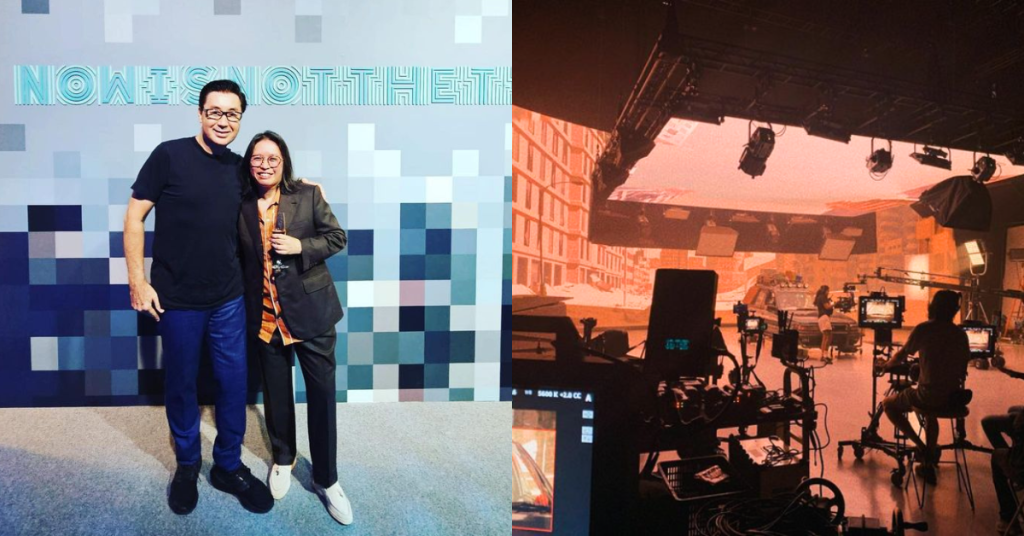
“As a country, we lag behind our neighbours and the world in terms of movie and television because of [the] lack of resources, spaces to film, talent, and viewers,” Karen Seah, the co-founder of X3D Studio said to Vulcan Post.
“However, if we’re able to lead in the space of virtual production, we’ll be able to expand the possibilities for our media industry in terms of opportunities, projects, creativity, and jobs.”
So that’s exactly why she and her co-founder, Myke Brown, opened X3D Studio in Singapore, which is said to be the largest Southeast Asian virtual production studio.
Dictionary Time: Virtual production is technology whereby LED panels are used as a backdrop for a set, on which video or computer-generated imagery can be displayed in real-time.
From old to something new
Housed in a 40,000 sq ft old power station with high ceilings of 25m, the studio is a stone’s throw away from Labrador Villa MRT.
A total of S$8 million was spent on refurbishment to turn the site into a state-of-the-art studio. It features a beautiful steel architectural wall that separates the main studio from the event space, as well as a lounge, editing studio, crew area, mini studio, and artist changing rooms.
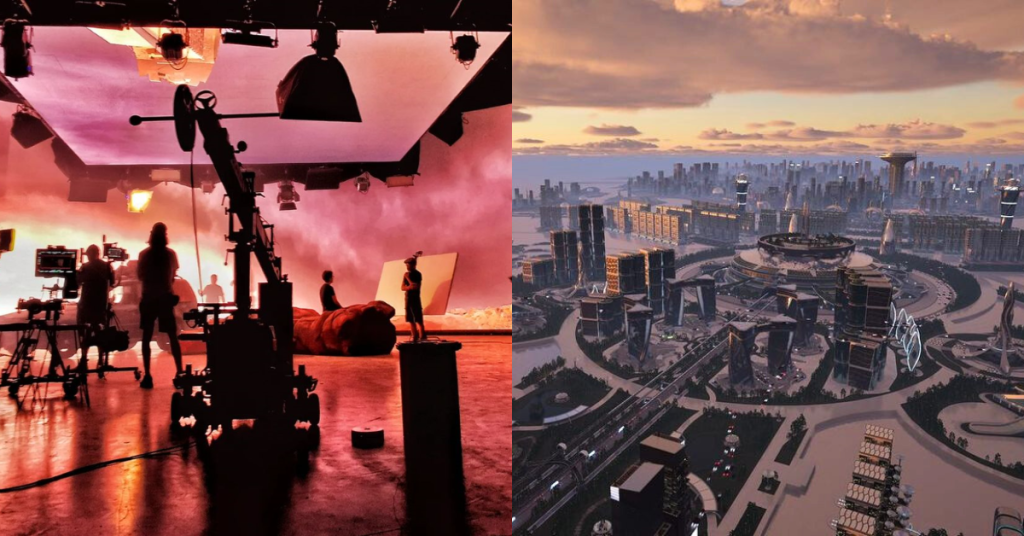
But what makes it live up to the co-founders’ goal of X3D Studio being a market leader is the technology.
It’s one of the world’s first virtual ICVFX (in-camera visual effects) production studios that is accredited by ARRI, a leading tech company in the filming industry.
Customers of the studio will benefit from ARRI technology, including an ALEXA 35 camera and Signature Prime lenses, SkyPanel X, and Orbiter lighting fixtures. It also houses INFiLED‘s LED display (which has impressive specs in colour accuracy) and OptiTrack for precise camera tracking amongst other quality filming equipment.
None of these names may mean much to the regular joe but the general premise is that all these factors combined will help filmmakers achieve their creative visions more easily.
Bridging the talent gap
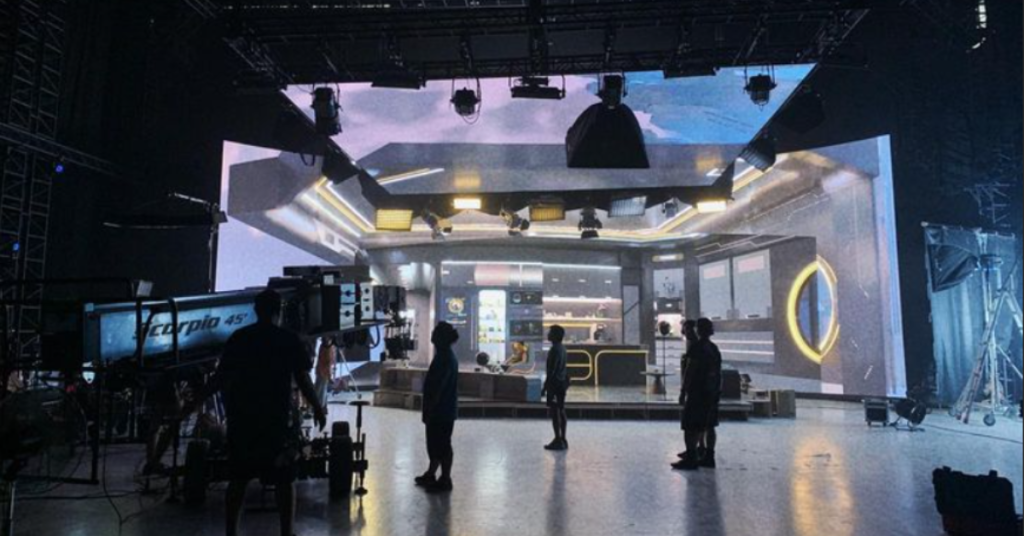
The decision to establish X3D Studio came about two years ago, and it took them a year and a half to make this a reality.
Sharing with us, Karen explained that they realised how beneficial it would be to combine their experiences in different lanes of the media industry. Together, they could build a forward thinking, state-of-the-art studio in Southeast Asia.
“As both of us have been producers for many years, we see that it is necessary for us to be ready for the future of filmmaking,” she said. “Virtual production represents a whole evolution, and not merely an upgrade. We knew that it was going to happen and we wanted to be market leaders in this sector.”
According to her, achieving this required them to check off two boxes: building a world class studio and bringing world-class projects into this studio.
The studio would provide them with the appropriate space to collaborate with “the very best partners” and train the best teams to service world-class projects. On that note, X3D Studio will be working with Nanyang Polytechnic to conduct two of three courses in virtual production.
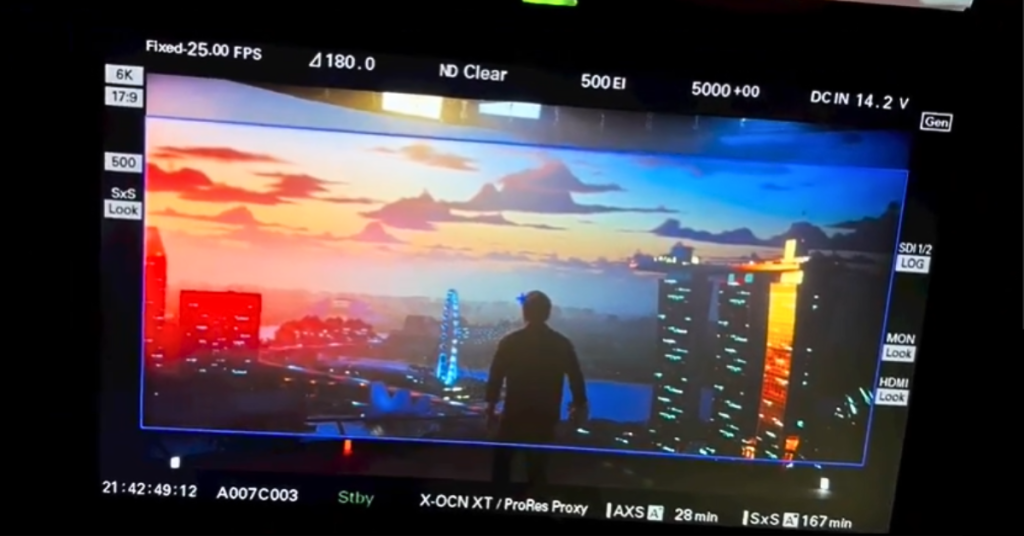
Through this, the studio aims to train budding creatives and grow the talent pool for the virtual production industry in Singapore.
This aligns with the government’s vision as well. In December last year, the Infocomm Media Development Authority (IMDA) announced a funding of S$55 million to support international co-productions and enhance local virtual production capabilities.
Creating new jobs along the way
Finding the right space was essential to setting up X3D Studio. It needed to be the right size, have the right ceiling height, structure, and floor plan, while still being convenient for clients and students.
So when the co-founders found this old power station, they knew it was the spot for them. It just needed a little bit of TLC (tender, loving, care).

“25 Pasir Panjang was an unused building that was in a very bad state. While it is prime land, it was in no condition to be used for anything,” Karen shared. “Therefore, I spent more than a year going through the process to rent this building and make the space usable [with a] considerable amount of Capex.”
As for the ARRI accreditation, it took them 10 months of auditing, inspecting, and team training. Every single product, equipment, and setup had to be assessed before the studio got accredited.
With this stamp of approval, the studio sees it as a big win for Singapore and the future of the virtual production industry here. It signals to the world and clients (like directors and television companies) that the nation is able to produce top quality films.
At the same time, they’re expecting the studio to create new job roles that previously never existed in Singapore. This in turn would have schools coming up with new curricula to meet industry demands.
Each time the co-founders shoot a project, they hire at least 30 pax on set. The duo expect to be doing one to two projects a month of different sizes. This means that each month, they’re hoping to hire up to 60 freelancers.
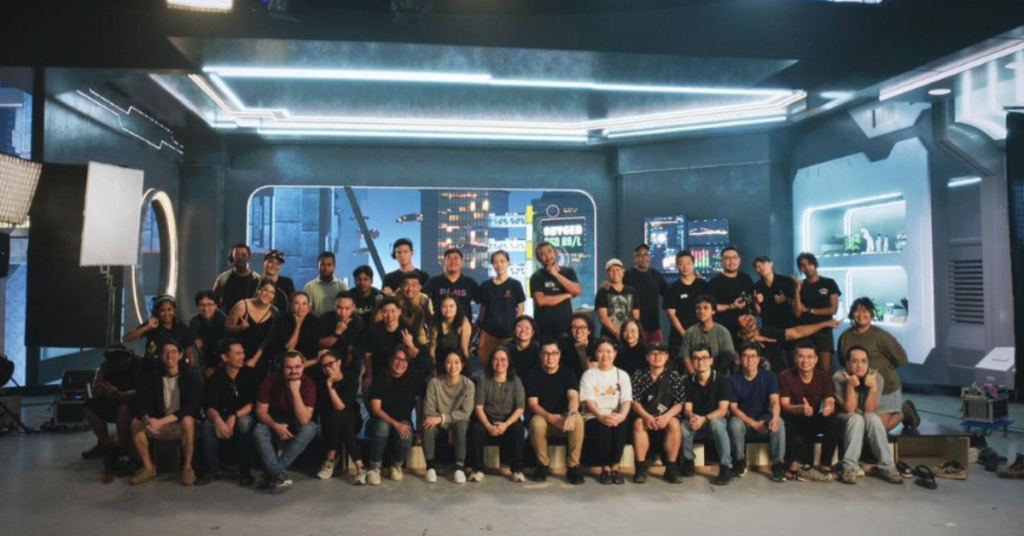
Starting off with new films
All that said, a lack of local awareness and exposure on virtual production still poses a challenge.
“People don’t understand what virtual production is in the first place because nobody writes about it, nobody wants to cover it,” Karen expressed. “How we intend to address this is to produce our own projects using virtual production, as well as to actively woo international producers to come to our studio.”
“We know what we are doing is really amazing and if it’s good enough for international producers, perhaps we might finally be seen here [in Singapore].”
X3D Studio recently marked its launch with the premiere of “Dead End“, a sci-fi short film starring Qi Yuwu. Its second film that’s also produced in-house is titled “Trap” and will be released on July 17, 2024.

In time, they hope the local media landscape will come to embrace virtual production. But for now, they’ll focus on bringing more global projects into Singapore and upskill as many freelancers as possible.
The studio is currently about to start working on an international film, of which they’re also co-producing.
Also Read: Say goodbye to lost packages & missed deliveries. Sunway Popbox is changing the game.
Featured Image Credit: X3D Studio
This new M’sian e-hailing biz is changing the game for drivers with its subscription model

Hailing a ride in Malaysia can be a gamble. Surge pricing during peak hours? Long waits while the app endlessly searches for drivers?
MyRide, a new homegrown e-hailing app, promises to be the answer to our woes.
But can this local challenger compete with established giants like Grab and the budget-friendly inDrive?
Steering towards driver benefits
Azleen Othman, CEO and founder of MyRide, comes from a background in banking and the corporate world. It’s a surprising leap, but one that Azleen believes gives her a strategic edge.
Her experience influences her approach to the e-hailing business in structured, high-stakes environments.
“We have a USP for drivers. Our subscription plan is a non-commission-based model, which allows drivers to earn higher profits,” she explained.
In the ongoing fare wars between e-hailing giants, MyRide offers a significant advantage to its drivers: higher revenue.
This is due to their subscription plan for drivers which is a stark contrast to the commission-based model most e-hailing apps use.
MyRide currently has four different subscription plans—three days (RM10), seven days (RM20), 14 days (RM55), and 30 days (RM110).

Let’s say you’re a driver who makes RM200 a day. Under the traditional commission system, you might lose 20% of that to fees, which comes out to RM40. Over a month, that adds up to a whopping RM1,200. Talk about a dent in your wallet.
However, with MyRide, there are no commissions. You buy a monthly subscription plan for just RM110, and that’s it. You keep 90% of your earnings. So, if you make RM200 a day for the whole month, that’s RM6,000 that goes straight into your pocket. MyRide only takes the RM110 subscription fee.
This is a compelling selling point for drivers who are often caught in the crossfire of fluctuating fares as it gives them more control over their income.
MyRide’s model promises more stability and better earnings, which could attract drivers looking for a more reliable income.
Additionally, MyRide has diversified its revenue streams. Beyond just ride fares, they’ve tapped into car advertising and partnerships with telco companies to sell data packages to both drivers and passengers.
This multifaceted approach could provide a more sustainable business model for MyRide itself in the long run.
Plus, they also dangle a rewards programme with an upcoming “giant company collaboration,” which they will announce soon. However, she did not mention the giant company specifically.
Standing out from the crowd
MyRide emphasises its local roots, banking on Malaysians supporting homegrown businesses.

Azleen is convinced that Malaysians are eager to support homegrown brands rather than sticking with a single monopoly brand for a long time.
This local focus could be a significant draw, but it remains to be seen if it’s enough to sway loyal customers of other established brands.
One of MyRide’s standout features for users is the Bid & Ride function, which allows passengers and drivers to negotiate fares, similar to what inDrive does.
“MyRide runs on a hybrid system (2-in-1) system which gives the opportunity to passengers and drivers to negotiate their desired fares. We have seen good responses so far on Bid & Ride since the launch,” shared the founder.
This could help both parties, though it raises questions about predictability and consistency compared to other e-hailings’ fixed fares or approximate pricing.

Safety and security
Safety has long been a significant concern in the e-hailing industry. MyRide prioritises safety with an emergency icon connected to a 24/7 helpline and local emergency services in both driver and passenger apps.
They also have a tracking system that records car movements for up to three months. Future updates will include AI facial recognition and voice recording, promising even greater security, said Azleen.
Although it sounds good on paper, with great safety features comes great responsibility. MyRide will need to be transparent about user privacy policies in order to have the trust of users.
This is particularly relevant given recent criticisms of inDrive’s handling of passenger complaints, where a passenger was forcefully removed from a vehicle after the driver was notified of a complaint during the ride.
Cash only (for now)
As of now, MyRide is a cash-only zone. While this might cater to those who prefer traditional methods, it seems a bit behind the times compared to Grab, AirAsia Ride, and inDrive’s seamless cashless transactions.
Integration with e-wallets like Touch & Go is a must-have these days, and thankfully, MyRide shared that this should be coming to their app by July’s end.
Besides, MyRide said by partnering with Touch & Go under the Go Rewards programme, extensive rewards will be offered to their passengers.
“On top of that, we will explore more opportunities with SMEs and local brands to provide vouchers and rewards to add up to our reward programmes,” she said.
Challenges and future plans
Despite its innovative features, MyRide faces considerable challenges. The biggest hurdle is gaining the trust of drivers and educating them on accepting job orders.
Retaining users in a market saturated with established players is another significant obstacle.

However, Azleen is optimistic. “We always believe Malaysians will support a local brand. All we need to do is focus on our USP and retain drivers and passengers with our long-term marketing plans.”
MyRide currently has 6,000 registered drivers, with over 1,000 active drivers covering major cities. They’ve reached 13,000 passenger downloads and expect these numbers to grow with upcoming partnerships and promotions.
“For Sabah and Sarawak, we are waiting for our operating licence from the Commercial Vehicle Licencing Board (LPKP) and expect to be ready by August,” said Azleen.
Looking to the future, MyRide has ambitious plans. They aim to expand into the Southeast Asian market within five years and aspire to become a unicorn company. Their vision includes evolving into a super app offering services like food delivery, parcel services, drone delivery, and even an electric taxi fleet.
As someone who frequently uses e-hailing services, I can appreciate MyRide’s efforts to shake up the market. Their focus on local culture and driver-centric policies is refreshing.
However, the question remains: Can they truly compete with the likes of Grab, AirAsia Ride, and inDrive? Only time will tell. For now, MyRide offers a promising alternative, but they’ll need to keep innovating and proving their value to win over both drivers and passengers.
In a market as dynamic as e-hailing, the journey is just as important as the destination. And for MyRide, the ride has only just begun.
- You can learn more about MyRide here.
- Read other articles we’ve written about Malaysian startups here.
Also Read: Say goodbye to lost packages & missed deliveries. Sunway Popbox is changing the game.
Featured Image Credit: MyRide
Meet the startup that powers the backbone operations of over 7K M’sian F&B outlets
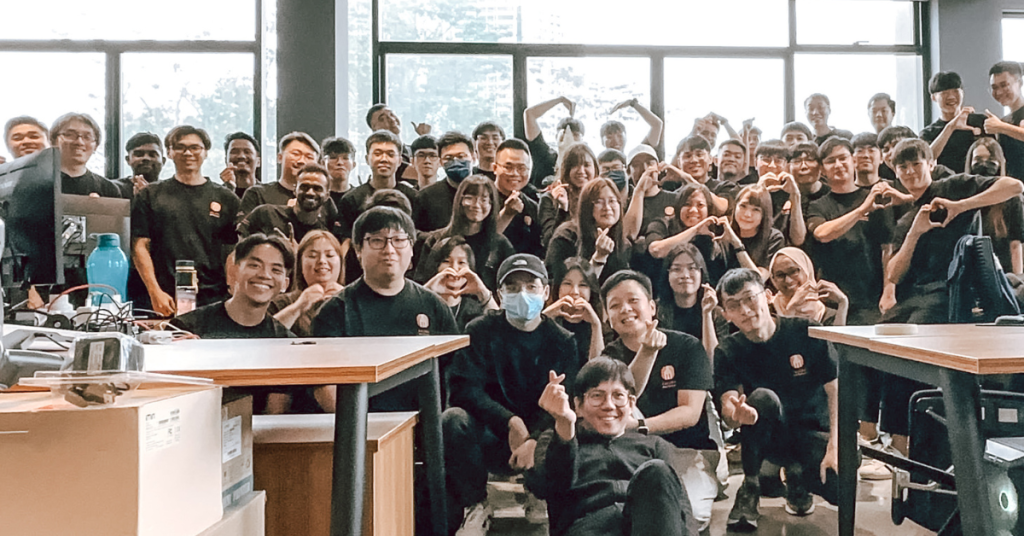
[This is a sponsored article with FeedMe.]
“We started understanding the frustrations in the F&B industry as we were building software for it,” Lo King Wei (King) told Vulcan Post.
While frequenting his favourite kopitiam in Johor, the IT engineer always noticed the inefficiencies at the beverage counter while ordering his kopi.
“The aunty will write on a piece of paper, and would have to shout the order to the back kitchen,” he shared.
In a noisy restaurant, this chaotic method can lead to human error and slower delivery times, souring customer experiences.
His friend and business partner, Squall Tan, wondered, “Is there a more convenient way to speed up this process?”
This led the duo to develop FeedMe, a point-of-sale (POS) system now used by over 7,000 merchants in Malaysia.
Serving efficiency
With Squall as the CEO and King as CTO, FeedMe launched in October 2019 as a POS system to digitalise the ordering process between customers and F&B merchants via QR codes.
Customers simply scan a QR code at their table, view the digital menu, place orders, and pay via the web app. It’s a system that became popular during the pandemic due to social distancing.
FeedMe also digitalises voucher systems by linking customer accounts to their phone numbers, solving the problem of forgotten vouchers.
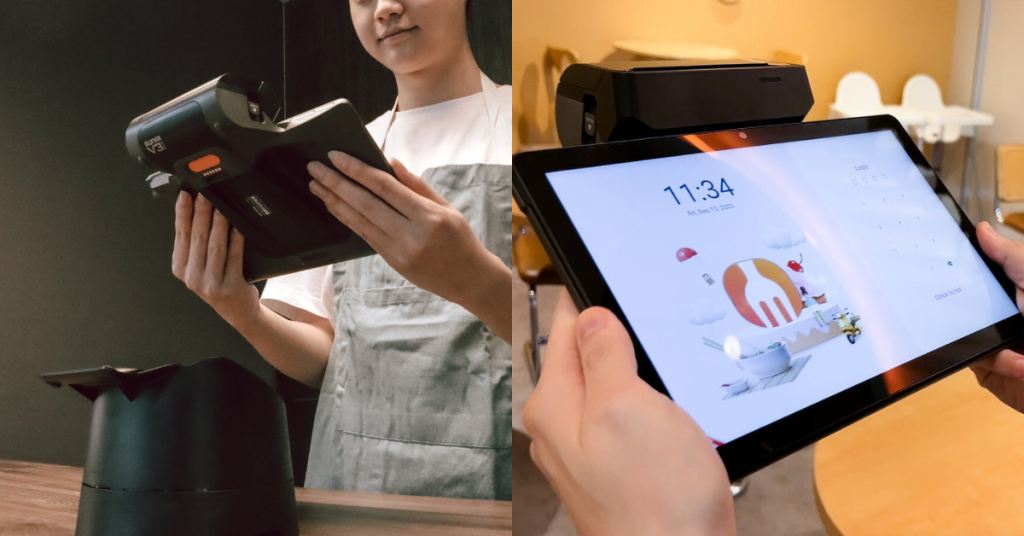
For merchants, FeedMe is more than a digital ordering platform.
Subscribers to this software-as-a-service (SaaS) get access to the full ecosystem which encompasses inventory management, kitchen display systems, delivery integration, monthly accounts reporting, and more.
FeedMe helps restaurants manage their backend operations effortlessly, reducing human error, improving operational quality, and saving costs.
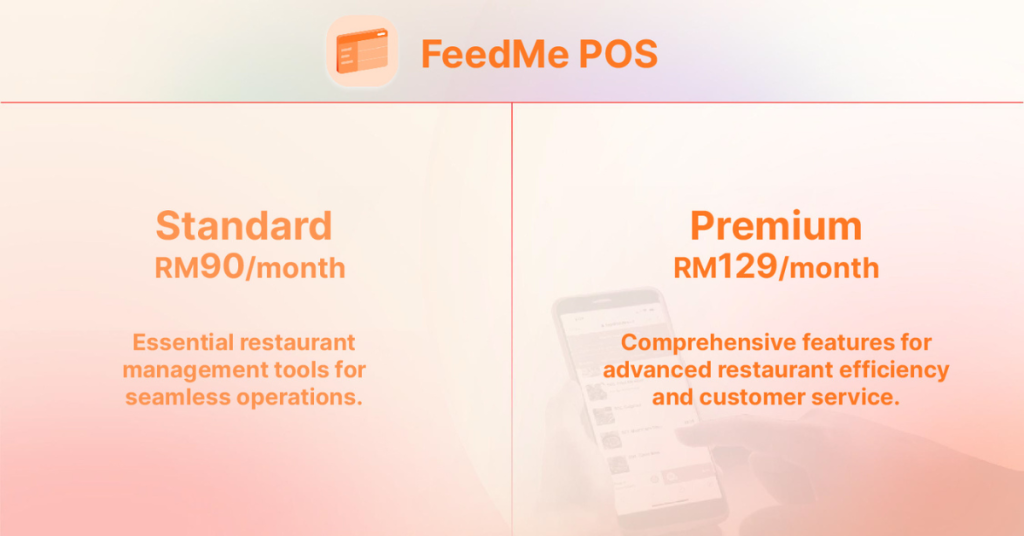
Starting at RM90/month, FeedMe’s POS system serves a range of F&B merchants, from old-time kopitiams and SMEs to large chain restaurants.
And they’re not stopping there. FeedMe’s team told Vulcan Post they’re rebranding from a POS startup to an AI-driven company.
Simplifying decisions
With AI developments booming, businesses globally are finding ways to make use of the tech to save time and cut costs.
Likewise, FeedMe has adopted AI for its merchants’ benefit by stacking smart functions onto existing features.
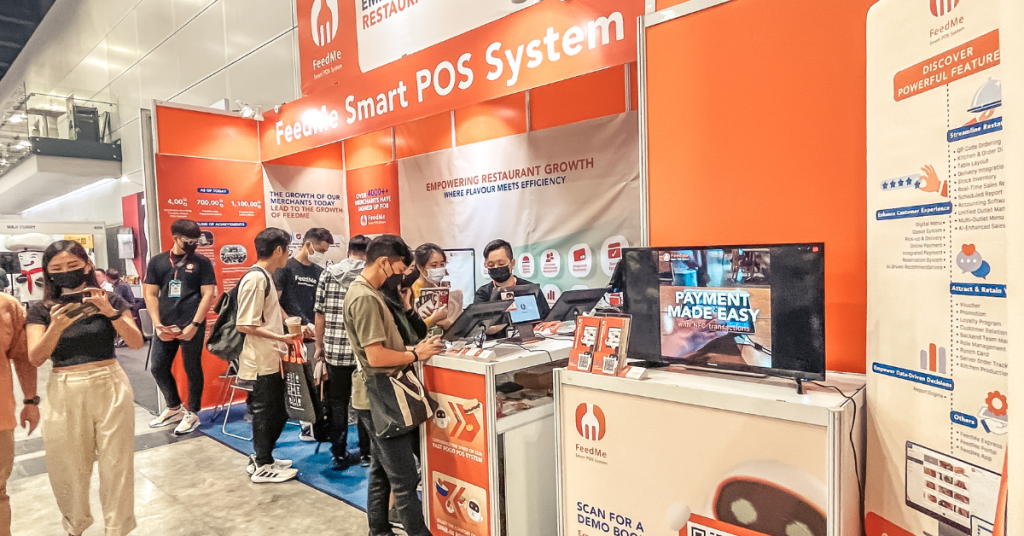
For instance, FeedMe’s AI uses the restaurant’s inventory system to create accurate and appealing dish descriptions when merchants upload their menus.
This matters, as research shows that including dish descriptions on menus can boost profits.
Additionally, FeedMe’s AI helps manage inventory nearing expiry, like milk. The AI notifies merchants and generates marketing campaigns to sell dishes containing this ingredient.
Merchants can also send SMS notifications to customers about these promotions by using FeedMe Connect (its CRM system). This can help increase sales for the restaurant and prevent inventory waste.
This SMS feature can also automatically send messages based on specific conditions and customer behaviours. For example, if a customer leaves negative feedback to a restaurant in the system, they will receive an apology message or other treats via SMS.
“Restaurants have to make many decisions every day. Our AI basically provides merchants with insights and actionables in real-time to help make business decisions,” said King.
This frees F&B owners from tedious decision-making, giving them more time to focus on improving their restaurant’s food and service quality.
And that’s FeedMe’s ultimate goal.
“We’re rebranding to AI not because it’s trendy, but because managing a business is tedious,” said Squall.
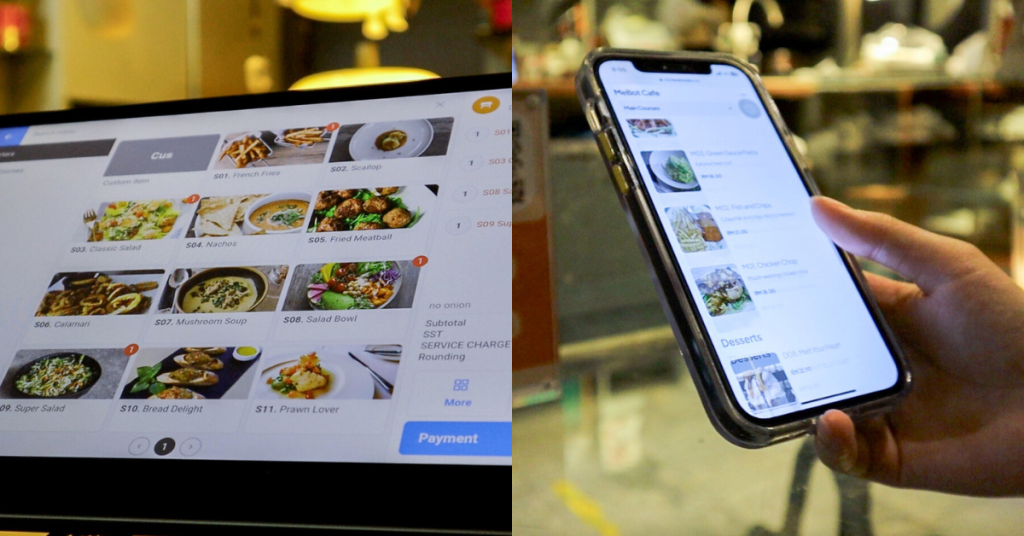
If merchants are unsure about a new AI feature or how to use it, FeedMe has included a helpful chatbot called Remy.
Venturing globally
In its five and a half years, FeedMe has onboarded nearly 8,000 merchants in Malaysia.
“In 2023, we saw a 590% growth compared to 2021, which is impressive, especially considering we lost almost two years due to the pandemic,” Squall noted.
FeedMe expanded to Singapore in 2023 and is now venturing into other SEA countries.
The co-founders understand that localisation is crucial to penetrate these culturally diverse markets.
Their strategy for scaling? Training FeedMe’s AI to develop its own software.
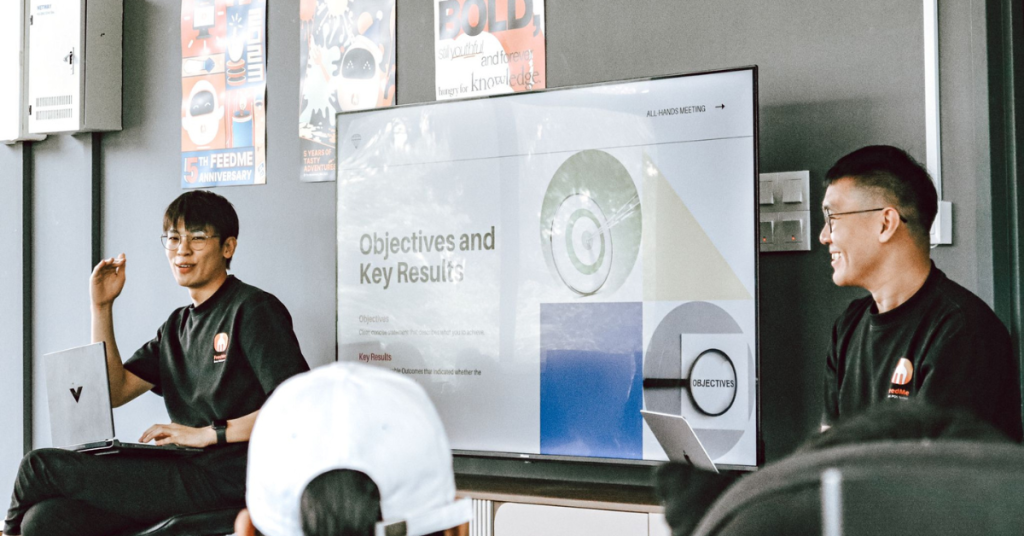
Squall explained that the team is training their AI to act as a professional account manager, making microdecisions and solving problems it identifies.
For instance, the AI is being trained to translate languages for the user interfaces in different countries effectively. The AI is also learning to identify issues in FeedMe’s software for developers to fix based on its suggestions.
“Our AI team is continually researching and working hard to provide fascinating features and AI solutions,” Squall shared. “We hope that at least 25% of the FeedMe product will be enhanced and supported by our AI, Remy.”
By 2024, the team aims to reach at least 12,000 merchants and expand to a total of five countries.
“In the next five years, we aim to serve at least 100,000 F&B SME merchants worldwide, helping them embrace AI and our ecosystem to grow their businesses,” he said.
Also Read: Say goodbye to lost packages & missed deliveries. Sunway Popbox is changing the game.
Featured Image Credit: FeedMe
Spruce up your mechanical keyboards with artisanal keycaps by these 7 M’sian brands
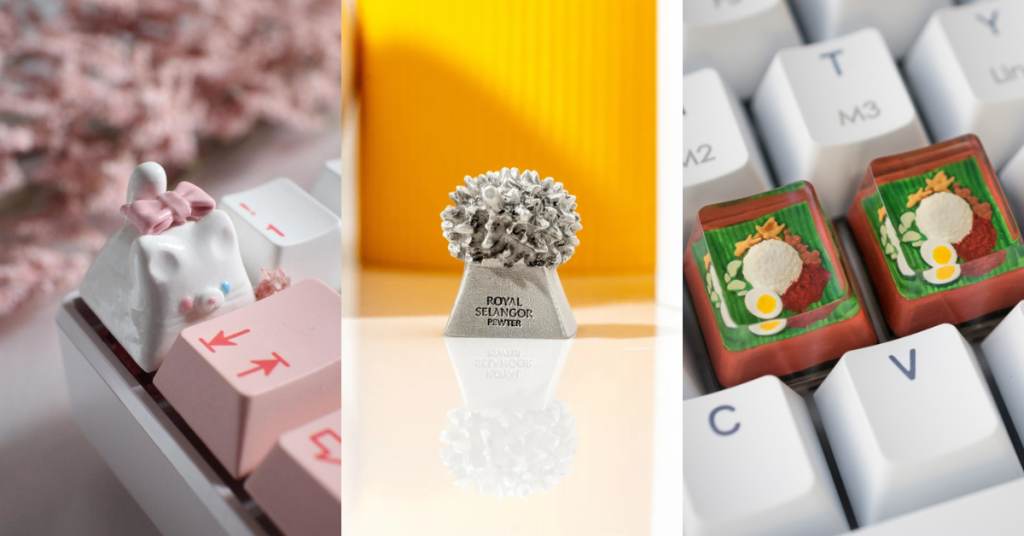
If you were active on the internet during the pandemic (and come on, who wasn’t?), you’d recall that mechanical keyboards had been all the rage.
Even if you weren’t in the community, or were personally vested in buying into the culture, you likely have scrolled past videos where people were click-clacking away at their customised mechanical keyboards.
This might have something to do with the fact that many of us were working from home and were interested in upgrading our gear, or maybe just the fact that we were chronically online and found ourselves consuming diverse content.
While the keeb craze seems to have died down a little these days, there’s still quite the community of people who are looking to build their dream keyboard or further customise the ones they already have. And when it comes to customisation, what better way to personalise than through artisanal keycaps?
And why not support local while you’re at it?
1. The KapCo
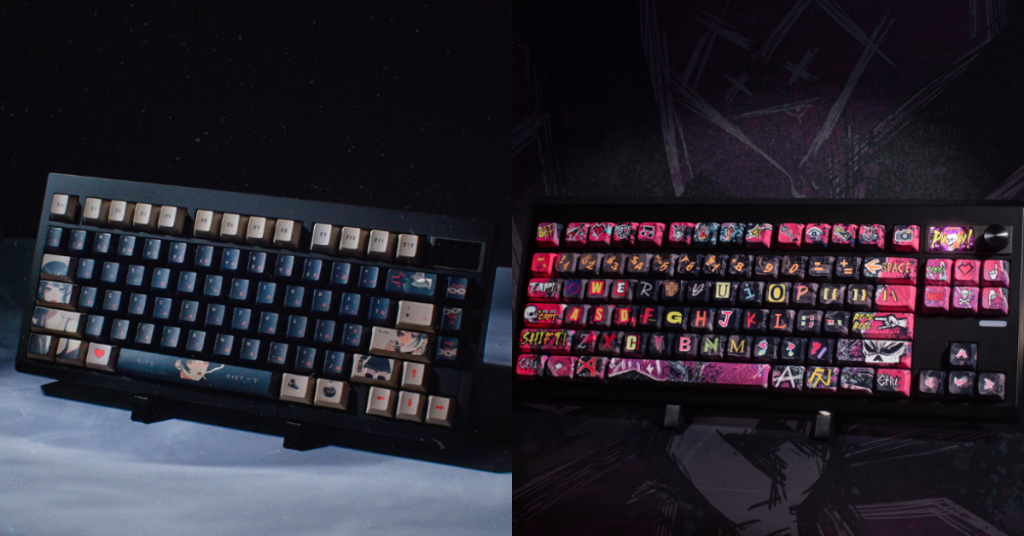
Initially starting as a reseller of plain-coloured keycaps for mechanical keyboards, The KapCo is now a homegrown brand that has its own range of bespoke caps.
Aside from their The Kapco Colorway and The KapCo Original, the business has even worked with international artists for its Artist Collection to create unique keycaps. They’ve even designed keycap sets with global keeb brands like Gateron and Mocankeys.
They’ve got something for everyone here, whether you enjoy a simplistic design, or more artistic ones. Aside from caps, they also offer other accessories like desk mats, keyboard frames, and more.
While the other brands on this list mainly sell artisanal keycaps individually, The KapCo sells primarily in sets.
Where to buy: Website
Price: Starts from RM235.99
Socials: Instagram
2. Zomgkey
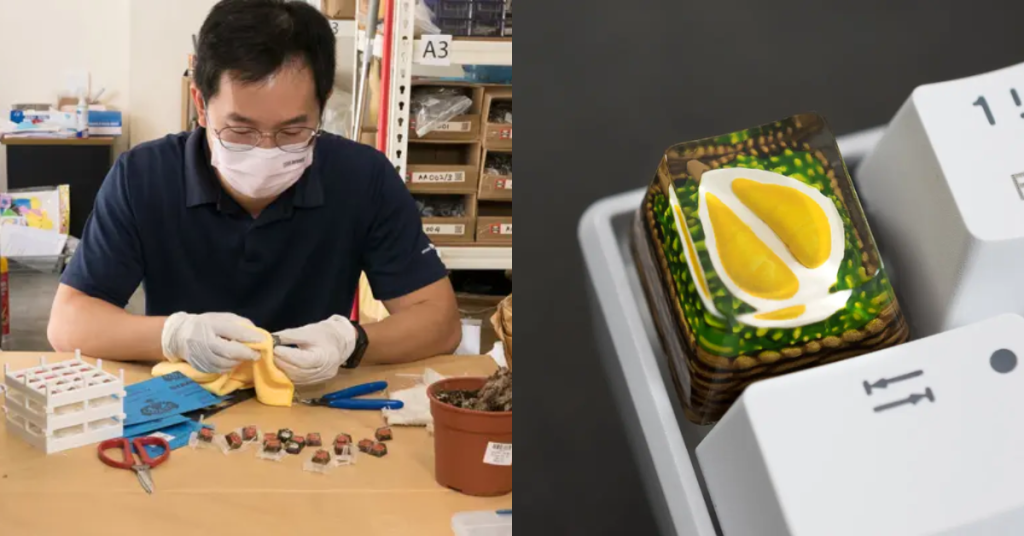
Founded in 2022, the Kuala Lumpur-based brand was founded by local artist Chorng.
His art features many localised designs, such as Malaysian delights like roti canai, nasi lemak, and durian. If you’re not too keen on going the food route, Zomgkey also has a rafflesia keycap that is oh-so beautiful.
Zomgkey’s signature style involves a clear resin top to showcase and protect the actual art, while giving a sense of depth.
Where to buy: Website
Price: Starts at RM119
Socials: Instagram
3. The Project Mew
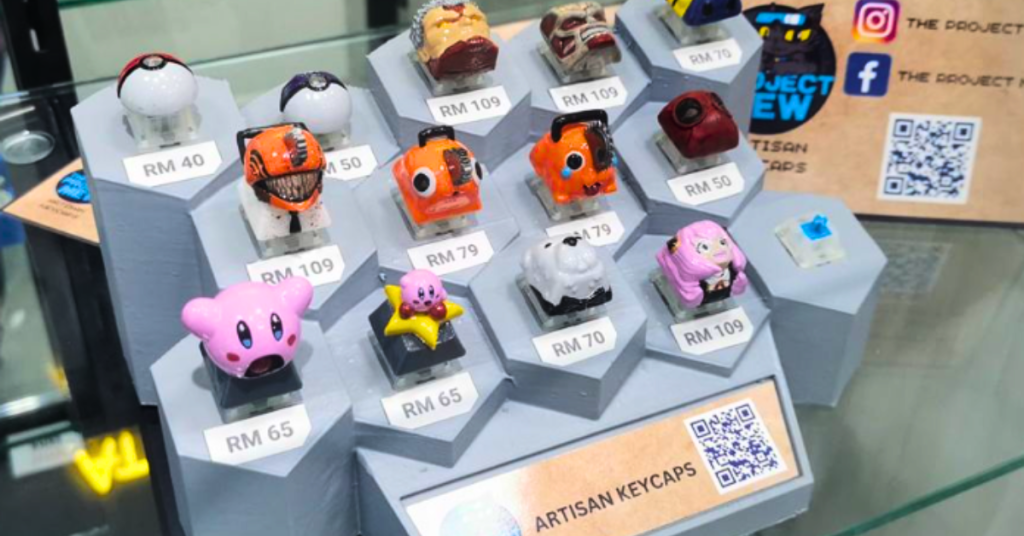
Fans of Pokémon will likely recognise this brand’s name as the research project in the series that involves finding Mew and collecting genes of various Pokémon.
This Shah Alam-based brand specialises in customised 3D prints, which make for some pretty unique designs.
Its catalogue of keycaps includes ones depicting Pokémon, Nintendo characters like Mario and Kirby, Star Wars-themed creations, and so much more. You can take a peek of the full catalogue here.
Where to buy: MKB.MY stores
Price: Starts at RM40
Socials: Instagram
4. Rebult Keyboards
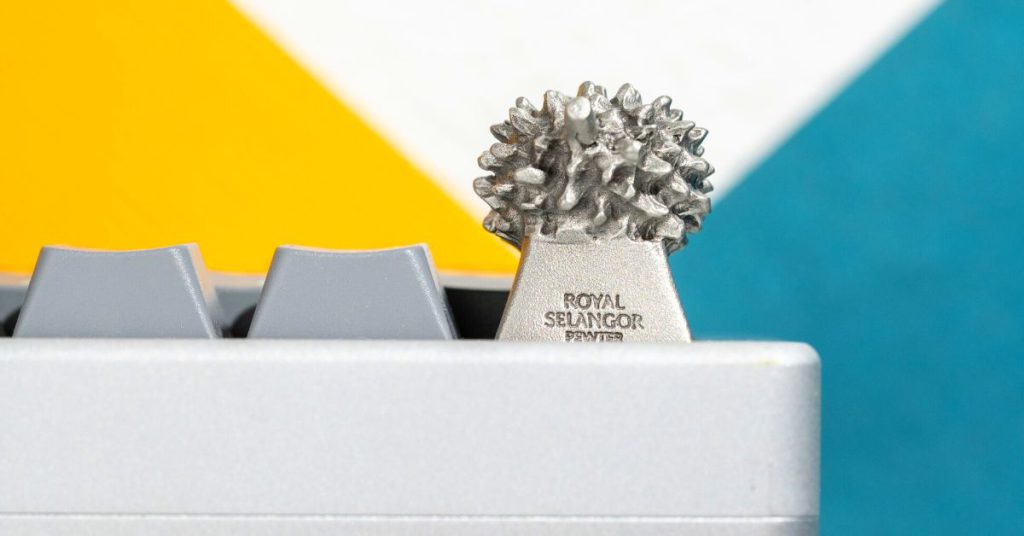
Founded in 2020, Rebult Keyboards is another brand that actually focuses on selling all things mechanical keyboards. The founders believe that they were among the first to start bringing in more products from abroad to Malaysia.
On top of offering their array of keyboard accessories and parts, the brand also got into the business of creating its own keycaps.
Well, specifically, they’ve worked with Royal Selangor to create some one-of-a-kind pewter caps. These are the only exclusive keycaps they seem to have released, but it appears to still be available, so if you’re looking for a real, Malaysian collector’s item, look no further.
Where to buy: Website
Price: RM269.25
Socials: Instagram
5. Ducky Caps
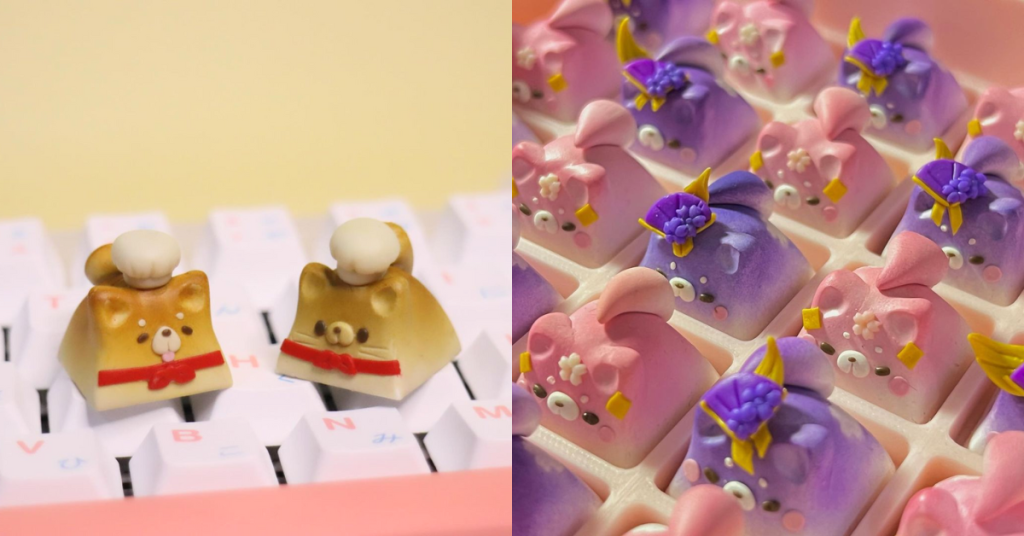
Behind Ducky Caps is a clay craft artist by the name of Aena. Based in Kuala Lumpur, this brand was established in March 2021 and features super adorable keycap creations. Personally, the ones featuring felines and Corgis are especially cute.
Aside from keycaps, Ducky Caps also produces charms, pins, and keychains. They take commissions as well, so if you like their art style, you can reach out through Instagram.
Where to buy: Instagram
Price: Starts from RM60
Socials: Instagram
6. Nunanaa
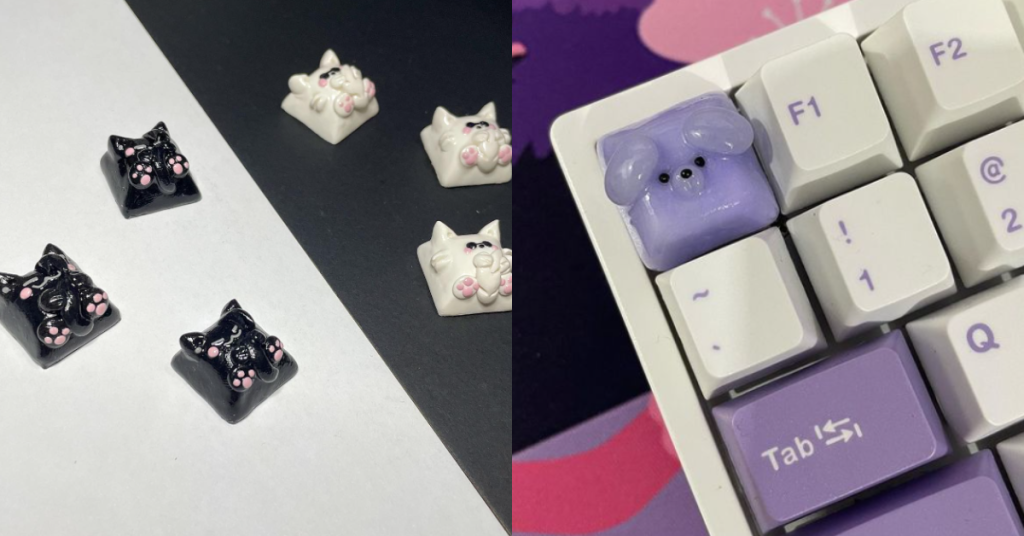
Based out of Sarawak, Nunanaa creates and sells a range of stickers, but also artisan keycaps. The artist has been crafting and selling these caps since February last year.
Nunanaa seems to specialise in characters. Their Shopee currently lists a number of polymer clay caps in designs like Inu (dog) and even Totoro. The brand is also open to commissions.
Where to buy: Shopee
Price: Starts from RM75
Socials: Instagram
7. Milkhue
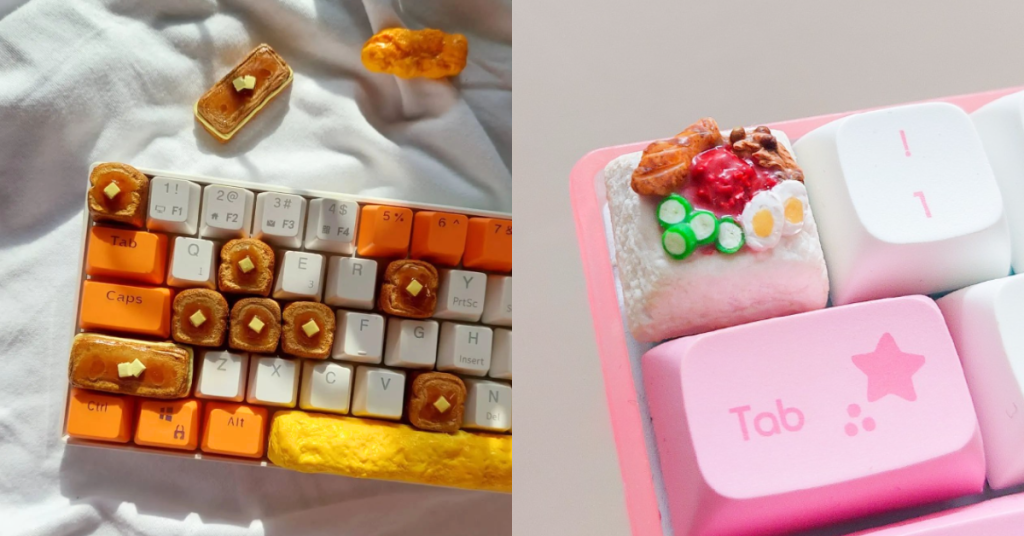
Established by Aida Masturina, who was 22 and a graphic design student at the time of founding, Milkhue is a purveyor of adorable, pastel-toned keycaps that range from decadent kaya butter toasts to Nasi Lemak.
Unfortunately, Milkhue is currently not taking orders. There hasn’t been an official announcement, but the brand was last active during CAFKL last year.
Still, considering how cute, we couldn’t leave them out of this list.
If you’re real keen on shopping her products, we actually spotted their products at MKB.MY in SS15, so you might want to try your luck there.
Where to buy: MKB.MY store
Price: N/A
Socials: Instagram
Keebing up with the community
Over the years, as the mechanical keyboard community has grown, so has various keycap artists. But just as many have come, many have also gone.
Milkhue might be one, but there are others, with others being PopKeys, Kapsule Lab, and certainly many more.
While it’s understandable that not all brands will withstand the test of time, we hope to see the names on this list continue to offer keyboard enthusiasts in Malaysia a way to showcase their personalities while spotlighting local artists.
- Read other articles we’ve written about Malaysian startups here.
Also Read: Tech enthusiast favourite Meizu makes a comeback in M’sia with new AI ecosystem & products
Featured image Credit: Duck Caps / Rebult Keyboards / Zomgkeys

